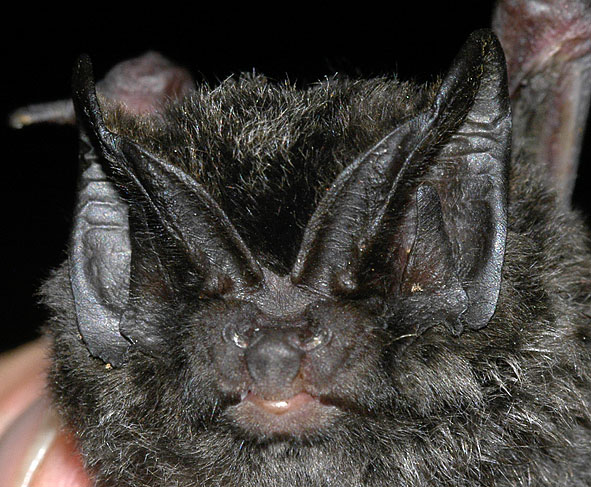Eastern barbastelle: Red Data Book of Armenia

Vesper bats - Vespertilionidae
Status. Listed in the IUCN Red List of Threatened Species (ver. 3.1) as Least Concern. According to IUCN criteria categorized as Vulnerable VU B1ab(iii).
Distribution. Distributed over a vast area from the South Caucasus to Kazakhstan and the Himalayas, eastwards to the Sichuan Province.
Distribution in Armenia. Armenia represents the westernmost part of the range of this rare species. Here, the barbastelle is spread over the vicinities of Yerevan and in the provinces of Kotayk (Garni, Geghard, Arzni, Abovian), Vayots Dzor (Arpi, Elpin, Chiva, Areni, Her–her, Martiros and others), Syunik (Khndzoresk, Ernadzor, Meghri and Goris), Tavush and Lori.
Habitats. Usually it lives and hibernates in caves and grottos, occasionally in cellars and lofts. Prefers the areas in sparse forests and near the water bodies.
Biological traits. Never forms big colonies, usually lives individually or in small groups (2–7 individuals). Active throughout the dark time. In late May–early June the female gives birth to one baby, seldom to twins. In winter bats move to deeper and warmer shelters. Feeds on flies, mosquitos, small butterflies and beetles.
Population size and its trends. The range is shrinking from the north towards the south. Even in typical occurrence sites its population is decreasing.
Major threats. Deterioration and destruction of suitable shelters.
Conservation measures. Some caves are included to the list of natural monuments. The Magili Cave was closed to human visitations. It is essential to close all bat caves to human access, particularly the Ptichya and Chaikend caves inhabited also by Mediterranean horseshoe bats.
Suggestions
 The Ministry of Environment sent a letter international partners to draw their attention to the real danger of environmental disasters as a result of Azerbaijan's large-scale aggression towards the territory of Armenia
The Ministry of Environment sent a letter international partners to draw their attention to the real danger of environmental disasters as a result of Azerbaijan's large-scale aggression towards the territory of Armenia
 Vicia pisiformis: Red Data Book of Armenia
Vicia pisiformis: Red Data Book of Armenia
 Vavilovia formosa: Red Data Book of Armenia
Vavilovia formosa: Red Data Book of Armenia
 Trigonella capitata: Red Data Book of Armenia
Trigonella capitata: Red Data Book of Armenia
 Trigonella astroides: Red Data Book of Armenia
Trigonella astroides: Red Data Book of Armenia












